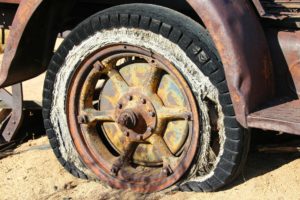Keeping cars on the road instead of on the roadside depends a great deal on keeping tires properly inflated, aligned, and maintained. Damage to the tire and improper tire wear can lead to a bumpy or rough ride at first, and end up requiring tire replacement sooner than expected.
Tires must have adequate treads to maintain the friction on the road that keeps the wheels turning underneath the car while the car drives forward—otherwise braking becomes more dangerous and steering becomes much more difficult. It’s especially important in rain, snow, or other slippery road conditions. Badly worn or damaged tires can ultimately blow out in the middle of the freeway if the problem is not addressed.
Common Tire Problems
Here are some important tire wear and tear issues to watch out for.
- Improper inflation. Wear concentrated in the middle of the tire typically means that the tire is overinflated. Wear on the inner and outer sides of the tire, where it is meeting the road more than usual, typically means that the tire is underinflated. Tire inflation guidelines can be found in the owner’s manual and on the inside car door placard. (The tire itself also has recommended inflation, but the numbers written in the car will be a better guide as to what tire inflation levels the car is designed for.)

- Heel/toe tire wear. When the car’s tires are pointed inward or outward, uneven wear occurs and can occur very quickly. This tire misalignment may not actually cause a noticeable pull when steering, so it’s important to check for it.
- Camber wear. Also called one-sided tire wear, this can be caused by a different tire alignment problem, where the tires are either slightly splayed outward or slightly bowed inward. This means that either the inner or the outer part of the tire is more worn than the rest.
- A combination of alignment problems can lead to tire treads can start to shift. This means that running a hand over the treads in one direction (left to right or right to left) will feel extremely rough, while running a hand over them the other direction will feel very smooth (depending on which direction the tire is turned).
- This wear pattern will have high and low spots throughout the circumference of the tire. There are several different scenarios in which it could occur, including bad shocks, which don’t properly absorb the vibrations and bumps in the road, or rear tire misalignment in a front-wheel drive car.
- When the layer of a tire start to separate, air can escape from the inner part of the tire into the outer layers, causing a bulge. Bulges in the sidewall are often caused by trauma to the tire, such as hitting a curb, while bulges in the tread are often caused by manufacturing defects.
Of course, also watch out for leaks, nails, holes, and tears in the tire treads and sidewall. To maximize tire lifespan, be sure to check tire pressure regularly and be on the lookout for anything unusual. Have All in the Wrist Auto check the alignment and tread depth checked if any unusual tire wear patterns start to occur.








